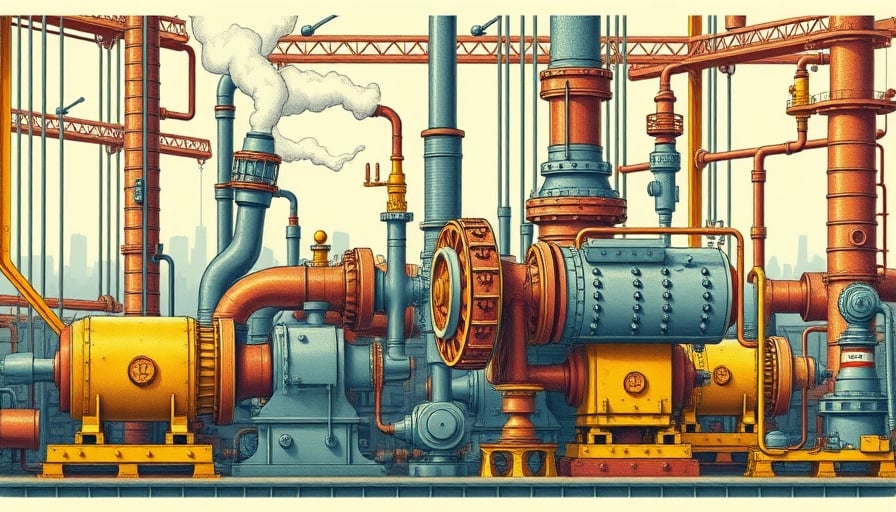Executive Summary
STMicroelectronics NV has unveiled a dual‑range motion sensor engineered for data‑intensive industrial applications. The move signals the company’s intent to deepen its footprint in the automation and industrial Internet of Things (IIoT) arena, where high‑resolution sensing is becoming a critical enabler of predictive maintenance, process optimization and edge intelligence. The announcement precedes a series of investor events, notably a presentation by CEO Jean‑Marc Chéry at the Morgan Stanley conference in Geneva, suggesting that STMicroelectronics is positioning the new product as a cornerstone of its future growth strategy.
1. Technological Context
1.1 Dual‑Range Sensing Architecture
The sensor’s dual‑range capability—combining low‑resolution, high‑frequency detection with high‑resolution, low‑frequency capture—offers a balanced trade‑off between power consumption and data fidelity. In practice, this means that a single device can monitor rapid vibrations in a drivetrain while also logging subtle temperature drifts over extended periods. Such versatility is essential for modern industrial workloads, where heterogeneous data streams must be fused in real time.
1.2 Alignment with IIoT Trends
Industrial automation is increasingly moving from rule‑based PLCs to data‑driven, AI‑augmented systems. According to Gartner, by 2028 the IIoT market will exceed $1.4 trillion, driven largely by the need for granular, actionable sensor data. STMicroelectronics’ motion sensor addresses this demand by enabling:
- Edge analytics – Low‑power processing of vibration signatures to detect anomalies before they propagate to costly downtime.
- Digital twins – High‑resolution motion profiles that feed simulation models, improving predictive fidelity.
- Hybrid cloud architectures – Seamless integration with existing IIoT stacks (e.g., OPC UA, MQTT) through standard interfaces.
2. Implications for Stakeholders
2.1 Industrial Operators
For manufacturing and utilities, the sensor offers a tangible path to extend asset life. A case study from Siemens, where a dual‑range vibration sensor reduced unplanned maintenance by 30%, illustrates the potential return on investment. However, operators must consider the data deluge—increasing sensor density can strain existing bandwidth and storage solutions. Moreover, the integration of new sensing layers into legacy SCADA systems often requires significant re‑architecture and staff retraining.
2.2 Technology Partners
STMicroelectronics’ positioning of the sensor as part of a broader portfolio—including semiconductors for telecommunications, consumer electronics, automotive, and computing—suggests a cross‑industry synergy. Partnerships with IIoT platform vendors (e.g., PTC ThingWorx, Microsoft Azure IoT) could accelerate adoption. Yet, competition from incumbents such as Bosch, Honeywell, and newer startups specializing in MEMS technology poses a challenge. Differentiation will hinge on power efficiency, calibration accuracy, and ease of integration.
2.3 Investors
The forthcoming investor events, particularly the Geneva conference, indicate that STMicroelectronics is seeking to communicate a narrative of strategic growth. The absence of immediate financial guidance limits short‑term valuation assessment, but the company’s focus on high‑margin semiconductor ICs and discrete devices—served across North America, Europe, and the Asia Pacific—aligns with investor appetite for resilient, globally diversified supply chains. Investors should scrutinize the cost structure of the new sensor, including fabrication yield, supply chain dependencies, and potential exposure to geopolitical risks such as US‑China trade tensions.
3. Risks and Challenges
| Risk | Description | Mitigation |
|---|---|---|
| Supply Chain Bottlenecks | Demand for advanced MEMS components could outstrip fab capacity, especially amid semiconductor shortages. | Diversify foundry partnerships; invest in in‑house packaging and test capabilities. |
| Security Vulnerabilities | IIoT devices are prime targets for cyberattacks; unsecured motion data could expose proprietary process parameters. | Embed hardware‑based encryption; support secure boot and firmware update mechanisms. |
| Data Privacy & Compliance | Industrial data often includes sensitive operational details that may fall under regulatory regimes like GDPR or industry‑specific data protection laws. | Implement anonymization protocols; ensure data residency compliance for global markets. |
| Integration Complexity | Legacy control systems may struggle to ingest and interpret new sensor outputs. | Provide SDKs, reference designs, and integration tools; offer consultancy services. |
4. Societal and Environmental Impact
4.1 Workforce Transformation
Enhanced sensing capabilities can shift workforce skill requirements from manual maintenance to data analytics and predictive modeling. This transition necessitates reskilling programs, potentially widening the digital divide if not managed inclusively.
4.2 Environmental Benefits
By reducing unplanned downtime and improving energy efficiency through predictive maintenance, the sensor indirectly contributes to lower carbon emissions. For instance, a study by the World Economic Forum estimated that widespread deployment of vibration analytics could cut energy consumption in heavy industry by up to 10%.
4.3 Ethical Considerations
The proliferation of motion sensors raises questions about surveillance within the workplace. While the primary data pertains to equipment, aggregated datasets could inadvertently reveal employee patterns if not carefully anonymized. Establishing clear data governance policies will be essential to balance operational transparency with employee privacy.
5. Looking Ahead
STMicroelectronics’ dual‑range motion sensor represents a strategic pivot toward the data‑centric future of industry. Its success will depend on:
- Demonstrating measurable ROI for early adopters through pilot programs.
- Securing strategic alliances with IIoT platform vendors and system integrators.
- Maintaining a robust, secure supply chain capable of meeting escalating demand.
- Investing in human capital to ensure that operators and analysts can fully leverage the enriched data streams.
As the company prepares to articulate its vision at the Morgan Stanley conference, stakeholders will be keenly watching whether the sensor delivers on its promise to bridge the gap between physical processes and digital intelligence, thereby reshaping not only industrial productivity but also the broader socio‑technical ecosystem.
